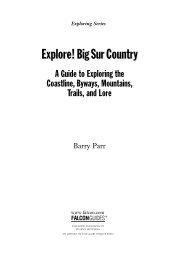Free pdf from Camping's Top Secrets - Falcon Guides
Free pdf from Camping's Top Secrets - Falcon Guides
Free pdf from Camping's Top Secrets - Falcon Guides
Create successful ePaper yourself
Turn your PDF publications into a flip-book with our unique Google optimized e-Paper software.
CAMPING’S TOP SECRETS<br />
and tin cans contain food. In each campsite<br />
there is seldom more than one or two trees with<br />
limbs high enough to deter a bruin. Bears aren’t<br />
stupid; they learn the location of these trees and<br />
make daily rounds to secure whatever is suspended<br />
<strong>from</strong> them. When they ind something<br />
(anything!) hanging <strong>from</strong> “their” tree, they’ll<br />
get it down, one way or another. All black bears<br />
(even fat old sows) can climb to some degree.<br />
And cubs climb like monkeys. If momma can’t<br />
get your food, the kids will!<br />
Young grizzlies can “claw climb” like black<br />
bears until they are about 4 years old, when their<br />
hooked claws straighten out. hen they will “hug<br />
climb” trees, just like you and I. Adult grizzlies<br />
have climbed trees and pulled people down! Polar<br />
bears are the only bruins that don’t climb trees.<br />
Steve hompson at Yosemite says bears<br />
have elaborate schemes for getting food. In an<br />
article by Suzanne Charle for the Milwaukee<br />
Journal Sentinal (November 30, 1997), hompson<br />
de scribed some of these schemes:<br />
4<br />
One time-honored precaution, hanging bags of<br />
food <strong>from</strong> a rope high in a tree, is now seen as<br />
useless. Local residents call the food bags “bear<br />
piñatas.” he bears chew of the rope that<br />
has been attached elsewhere, or chew of the<br />
branch that is supporting the bag. If the limbs<br />
are small, they’ll send the cubs out. If that<br />
doesn’t work, they’ll just climb above the bags,<br />
launch themselves out of the tree, and grab the<br />
bags on the way down.<br />
Recommendation: Double-bag (in plastic)<br />
all foodstufs, especially meats. If possible, ask<br />
your grocer to vacuum-seal smelly foods. Or<br />
buy your own vacuum-sealing machine. Set<br />
food packs on low ground (to minimize the<br />
travel of odors), well away <strong>from</strong> the conines of<br />
campsites and trails. As an added precaution,<br />
separate food packs by 50 feet or more. Do not<br />
put food packs in trees!<br />
If you’re camping in grizzly or polar bear<br />
country, locate your kitchen at least 50 yards<br />
downwind of your tents. Naturally, cooking areas<br />
must be scrupulously clean—free of the last Rice<br />
Krispie. Nonetheless, human odor is stronger<br />
than most food smells: Don’t be surprised if the<br />
bear smells you before he smells your food!<br />
If taking your food out of camp and hiding<br />
it in the woods works, why don’t federal<br />
authorities support this method?<br />
Mostly, it’s a matter of keeping people safe<br />
(i.e., “people here, food over there, yonder in that<br />
tree”). If a bear gets your food, it’s no big deal; if<br />
he gets you, it’s a very big deal! Federal authorities<br />
need a formula they can rely on—one that<br />
keeps people and food at a safe distance.<br />
As mentioned, I never hang my packs in<br />
bear country (it bears repeating that bears<br />
climb trees!). And unless required by law, I<br />
don’t use bear-proof containers. But I keep a<br />
scrupulously clean camp, and at night I put my<br />
food in a place where a bear is unlikely to see or<br />
smell it—thick bushes, a tight grove of trees, a<br />
depression, beneath an evergreen tree, etc. he<br />
bottom line is that if a bear can’t see or smell<br />
your food (vacuum-sealing will eliminate most<br />
odors), he won’t get it! I’ve lived by my rules for<br />
forty years, and in that time, neither I nor anyone<br />
in my charge has ever lost food or equipment<br />
to any animal. And that, friends, is the<br />
“bear” truth!<br />
Bear Encounters<br />
Here’s the recommended procedure in the event<br />
you meet face-to-face with . . .








